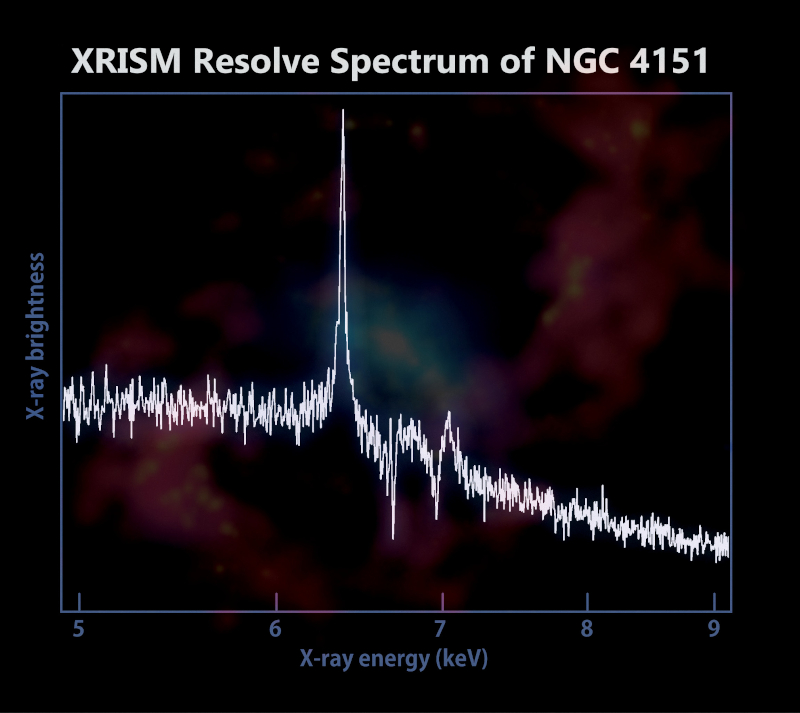
 Credit: Spectrum: JAXA/NASA/XRISM Resolve. Background composite: X-ray image, NASA/CXC/CfA/J.Wang et al.; optical image, Isaac Newton Group of Telescopes, La Palma/Jacobus Kapteyn Telescope; radio mage, NSF/NRAO/VLA
Credit: Spectrum: JAXA/NASA/XRISM Resolve. Background composite: X-ray image, NASA/CXC/CfA/J.Wang et al.; optical image, Isaac Newton Group of Telescopes, La Palma/Jacobus Kapteyn Telescope; radio mage, NSF/NRAO/VLA
The Iron Grip of the Black Hole in NGC 4151
The galaxy NGC 4151 is one of the closest active galaxies to our own Milky Way. Like the Milky Way, NGC 4151 is also a spiral galaxy, but unlike the Milky Way, NGC 4151 hosts a supermassive black hole near the galactic center, a black hole that is actively swallowing about an earth's mass of nearby gas and dust every minute from a torus of matter that surrounds it. Just before this matter spirals down into the black hole, past the event horizon never to be seen again, it produces an outpouring of X-radiation. Studying the X-ray emission from active galaxies is thus an excellent way to learn about the feeding habits of black holes, and to understand how thay grow. The image above shows, as a white graph, a high-resolution X-ray spectrum of NGC 4151 obtained by the Resolve X-ray micro-calorimeter, a revolutionary instrument on the XRISM X-ray space observatory. XRISM, launched on September 7, 2023, is a joint collaboration between the Japanese Aerosapce Exploration Agency (JAXA), NASA, and the European Space Agency (ESA). The Resolve micro-calorimeter measures the heat deposited when an X-ray is absorbed the detector and therefore can measure the energy of individual X-ray photons that fall upon it to very high precision, producing extraordinarily sharp measures of the energy distribution of the emitted X-rays. The high-resolution spactra that Resolve produces allows astronomers to study high-energy emission from groups of individual atoms in an X-ray source like NGC 4151. The bright spike of emission between 6 and 7 keV is emission produced by iron atoms excited by X-rays from near the central supermassive black hole. The shape of this spike, and how it changes with time, provide important clues about the physical state of the trapped gas feeding the black hole, and allows scientists to study the evolution of supermassive black holes over time.
Published: May 20, 2024
<
HEA Dictionary ● Archive
● Search HEAPOW
● Other Languages
● HEAPOW on Facebook
● Download all Images
● Education ● HEAD
>

Each week the HEASARC
brings you new, exciting and beautiful images from X-ray and Gamma ray
astronomy. Check back each week and be sure to check out the HEAPOW archive!
Page Author: Dr. Michael F. Corcoran
Last modified Tuesday, 28-May-2024 10:18:21 EDT


